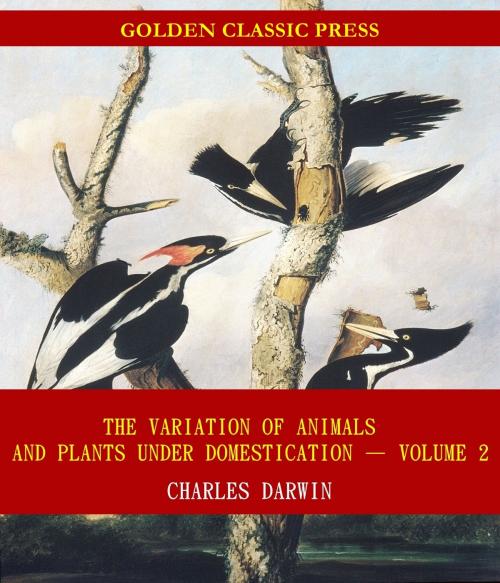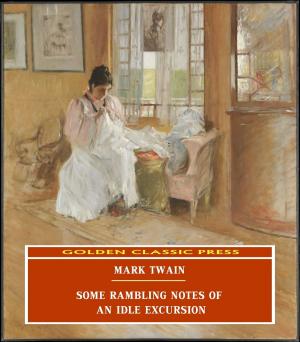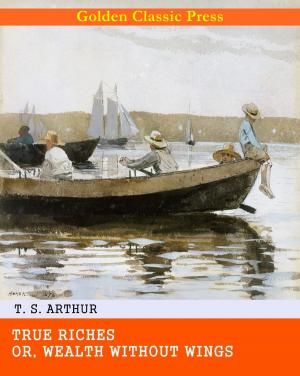The Variation of Animals and Plants under Domestication
Nonfiction, Religion & Spirituality, Philosophy, Religious, Social & Cultural Studies, History| Author: | Charles Darwin | ISBN: | 1230002981673 |
| Publisher: | GOLDEN CLASSIC PRESS | Publication: | December 7, 2018 |
| Imprint: | Language: | English |
| Author: | Charles Darwin |
| ISBN: | 1230002981673 |
| Publisher: | GOLDEN CLASSIC PRESS |
| Publication: | December 7, 2018 |
| Imprint: | |
| Language: | English |
*** Original and Unabridged Content. Made available by GOLDEN CLASSIC PRESS***
Synopsis:
The publication of Darwin's On the Origin of Species in 1859 ignited a public storm he neither wanted nor enjoyed. Having offered his book as a contribution to science, Darwin discovered to his dismay that it was received as an affront by many scientists and as a sacrilege by clergy and Christian citizens. To answer the criticism that his theory was a theory only, and a wild one at that, he published two volumes in 1868 to demonstrate that evolution was obvious to anyone who cared to look at a bull in a pasture or a dog on a hearth.In response to those who insisted that species were distinct since creation, Darwin pointed to breeders of pigs and pigeons. In reply to those who protested that human intervention is one thing and natural selection another, he argued, "If organic beings had not possessed an inherent tendency to vary, man could have done nothing." To counter those who scorned his descriptions of species in exotic places, he submitted local evidence of cabbages and cauliflower.
Based on a wide array of sources, from ancient pictographs to Polish roosters, from skins and from skeletons, from scientific journals and breeding manuals, Darwin assembled a mass of proof--and a hypothesis about species reversion that risked his reputation anew. The Variation of Animals and Plants under Domestication is a two-volume compilation of his thorough and intensive research and the revolutionary conclusions that resulted. The first portion of his work is dedicated to a meticulous analysis of various aspects of plant and animal life, including an inventory of varieties and their physical and behavioral characteristics, investigation of the impact of a species' surrounding environmentand the role that both natural and forced changes in this environment have had. Darwin then turns to a richly detailed discussion of the roles of inheritance and crossing in the development of species. A wealth of illustrations further support and enhance his findings. This fascinating, invaluable, and courageous undertaking eventually formed the foundation for our current understanding of evolution.
"In science as in politics the victors tend to write the history books. As a result, the record of the past is edited, intentionally or unintentionally, so that it focuses mainly on the precursors of contemporary orthodoxy. Such a focus may accurately represent the genealogy of modern ideas, but it almost inevitably misrepresents the historical experience of their progenitors... Even the powerful, persuasive, and ultimately triumphant theory of evolution by natural selection required not only defense, but repeated buttressing and revision. Variation showed Darwin hard at work on this rearguard action, using the materials he had at hand... His information was gleaned from the observations of fanciers, breeders, and amateur naturalists, as well as from the treatises of those on the cutting edge of zoology and botany. As hindsight narrows the historical spotlight, it imposes its own sense of hierarchy on the preoccupations of the past. But Darwin was interested in all of these topics, valued all of these sources, and belonged, to a greater or lesser extent, to all of these communities."--from the Introduction.
*** Original and Unabridged Content. Made available by GOLDEN CLASSIC PRESS***
Synopsis:
The publication of Darwin's On the Origin of Species in 1859 ignited a public storm he neither wanted nor enjoyed. Having offered his book as a contribution to science, Darwin discovered to his dismay that it was received as an affront by many scientists and as a sacrilege by clergy and Christian citizens. To answer the criticism that his theory was a theory only, and a wild one at that, he published two volumes in 1868 to demonstrate that evolution was obvious to anyone who cared to look at a bull in a pasture or a dog on a hearth.In response to those who insisted that species were distinct since creation, Darwin pointed to breeders of pigs and pigeons. In reply to those who protested that human intervention is one thing and natural selection another, he argued, "If organic beings had not possessed an inherent tendency to vary, man could have done nothing." To counter those who scorned his descriptions of species in exotic places, he submitted local evidence of cabbages and cauliflower.
Based on a wide array of sources, from ancient pictographs to Polish roosters, from skins and from skeletons, from scientific journals and breeding manuals, Darwin assembled a mass of proof--and a hypothesis about species reversion that risked his reputation anew. The Variation of Animals and Plants under Domestication is a two-volume compilation of his thorough and intensive research and the revolutionary conclusions that resulted. The first portion of his work is dedicated to a meticulous analysis of various aspects of plant and animal life, including an inventory of varieties and their physical and behavioral characteristics, investigation of the impact of a species' surrounding environmentand the role that both natural and forced changes in this environment have had. Darwin then turns to a richly detailed discussion of the roles of inheritance and crossing in the development of species. A wealth of illustrations further support and enhance his findings. This fascinating, invaluable, and courageous undertaking eventually formed the foundation for our current understanding of evolution.
"In science as in politics the victors tend to write the history books. As a result, the record of the past is edited, intentionally or unintentionally, so that it focuses mainly on the precursors of contemporary orthodoxy. Such a focus may accurately represent the genealogy of modern ideas, but it almost inevitably misrepresents the historical experience of their progenitors... Even the powerful, persuasive, and ultimately triumphant theory of evolution by natural selection required not only defense, but repeated buttressing and revision. Variation showed Darwin hard at work on this rearguard action, using the materials he had at hand... His information was gleaned from the observations of fanciers, breeders, and amateur naturalists, as well as from the treatises of those on the cutting edge of zoology and botany. As hindsight narrows the historical spotlight, it imposes its own sense of hierarchy on the preoccupations of the past. But Darwin was interested in all of these topics, valued all of these sources, and belonged, to a greater or lesser extent, to all of these communities."--from the Introduction.















